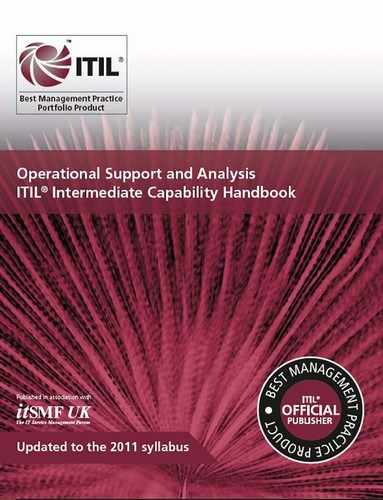1 Introduction to service management
1.2The ITIL framework (SO 1.2, 1.4)
1.4Processes and functions (SO 2.2.2, 2.2.3)
1.6Operational support and analysis within the context of the service lifecycle
2.1Purpose and objectives (SO 4.1.1)
2.3Value to the business and service lifecycle (SO 4.1.3)
2.4Policies, principles and basic concepts (SO 4.1.4)
2.5Process activities, methods and techniques (SO 4.1.5)
2.6Triggers, inputs, outputs and interfaces (SO 4.1.6)
2.7Information management (SO 4.1.7)
2.8Critical success factors and key performance indicators (SO 4.1.8)
2.9Challenges and risks (SO 4.1.9)
2.10Roles and responsibilities (SO 6.7.8)
3.1Purpose and objectives (SO 4.2.1)
3.3Value to the business and service lifecycle (SO 4.2.3)
3.4Policies, principles and basic concepts (SO 4.2.4)
3.5Process activities, methods and techniques (SO 4.2.5)
3.6Triggers, inputs, outputs and interfaces (SO 4.2.6)
3.7Information management (SO 4.2.7)
3.8Critical success factors and key performance indicators (SO 4.2.8)
3.9Challenges and risks (SO 4.2.9)
3.10Roles and responsibilities (SO 6.7.5)
4.1Purpose and objectives (SO 4.3.1)
4.3Value to the business and service lifecycle (SO 4.3.3)
4.4Policies, principles and basic concepts (SO 4.3.4)
4.5Process activities, methods and techniques (SO 4.3.5)
4.6Triggers, inputs, outputs and interfaces (SO 4.3.6)
4.7Information management (SO 4.3.7)
4.8Critical success factors and key performance indicators (SO 4.3.8)
4.9Challenges and risks (SO 4.3.9)
4.10Roles and responsibilities (SO 6.7.7)
5.1Purpose and objectives (SO 4.4.1)
5.3Value to the business and service lifecycle (SO 4.4.3)
5.4Policies, principles and basic concepts (SO 4.4.4)
5.5Process activities, methods and techniques (SO 4.4.5)
5.6Triggers, inputs, outputs and interfaces (SO 4.4.6)
5.7Information management (SO 4.4.7)
5.8Critical success factors and key performance indicators (SO 4.4.8)
5.9Challenges and risks (SO 4.4.9)
5.10Roles and responsibilities (SO 6.7.6)
6.1Purpose and objectives (SO 4.5.1)
6.3Value to the business and service lifecycle (SO 4.5.3)
6.4Policies, principles and basic concepts (SO 4.5.4)
6.5Process activities, methods and techniques (SO 4.5.5)
6.6Triggers, inputs, outputs and interfaces (SO 4.5.6)
6.7Information management (SO 4.5.7)
6.8Critical success factors and key performance indicators (SO 4.5.8)
6.9Challenges and risks (SO 4.5.9)
6.10Roles and responsibilities (SO 6.7.9)
7.3Organizational structures (SO 6.3.3)
7.4Staffing options (SO 6.3.4)
7.5Measuring service desk performance (SO 6.3.5)
7.6Outsourcing the service desk (SO 6.3.6)
9 Technology and implementation
9.1Generic requirements for IT service management technology (SO 7.1)
9.2Evaluation criteria for technology and tools (SD 7.2)
9.3Evaluation criteria for technology and tools for process implementation
9.4Practices for process implementation
9.5Challenges, critical success factors and risks relating to implementing practices and processes
9.6Planning and implementing service management technologies (SO 8.5)
11 Related guidance (SO Appendix A)
11.1ITIL guidance and web services
11.6ISO/IEC 20000 service management series
11.7Environmental management and green and sustainable IT
11.8ISO standards and publications for IT
11.9ITIL and the OSI framework
11.10Programme and project management
11.12Skills Framework for the Information Age
11.13Carnegie Mellon: CMMI and eSCM frameworks
